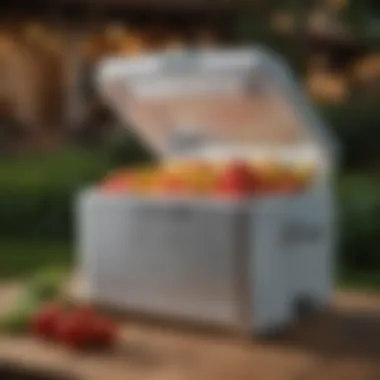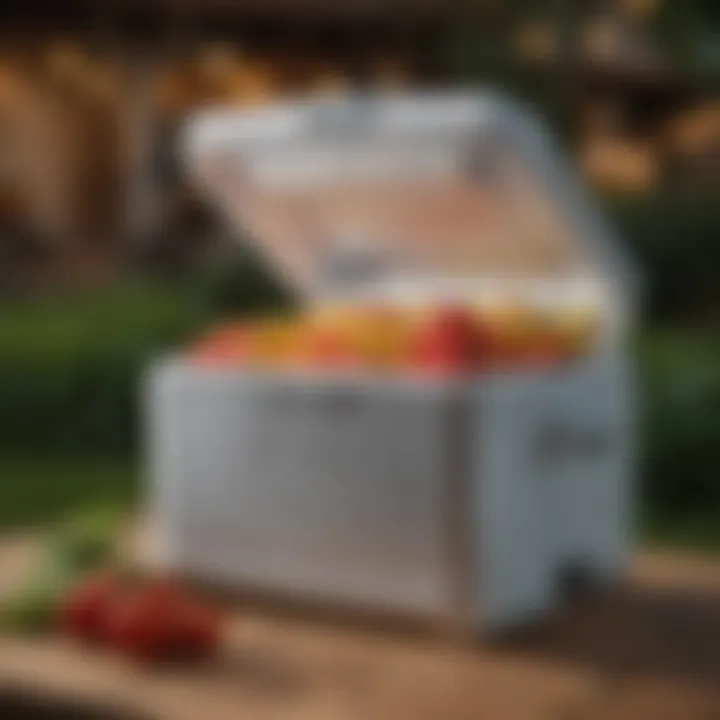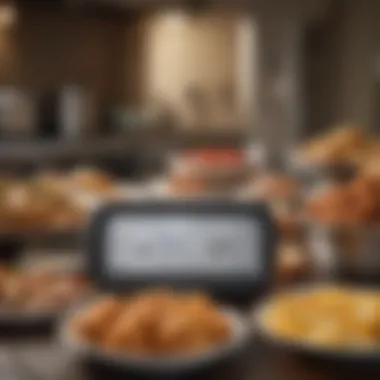Essential Tips for Keeping Food Cold Outdoors


Intro
Keeping food cold outdoors can be a real challenge, especially when the sun is blazing down or when you’re in a remote area away from the comforts of home. Whether it's a family picnic at the park, a beach barbecue, or a large outdoor wedding, maintaining the right temperature for perishable items is crucial not just for flavor, but for safety. No one wants to deal with foodborne illnesses that can arise from improper handling or storage of food. To avoid a culinary disaster, a thorough understanding of the methods and tools available can make all the difference.
Understanding the science behind food safety, especially when it comes to temperature control, can be your greatest ally in these situations. Improperly stored food can quickly spoil, leading to waste and, worse, health issues. That’s why we've compiled a comprehensive guide that dives into various strategies tailored to different outdoor settings.
You'll find practical tips for keeping your favorite dishes at optimal temperatures, insights on essential equipment to have on hand, and considerations for local climate factors that could affect your food safety practices. By the end of this article, you’ll be armed with knowledge and techniques that help ensure your meals remain both safe and scrumptious, no matter where your outdoor adventures take you.
Understanding Food Safety Principles
Food safety is not just a buzzword for chefs or event planners; it's a fundamental aspect of preparing and serving food outdoors. When you’re enjoying a sunny picnic or a barbecue in your backyard, the last thing on your mind is likely the risk associated with your food. However, understanding food safety principles can help you keep meals both safe and delicious.
Temperature management plays a pivotal role in food safety. Keeping food out of the temperature danger zone—which ranges from 40°F to 140°F—cannot be stressed enough. Many bacteria proliferate in this zone, putting everyone's health on the line. Here’s where temperature control enters the spotlight; it’s essential to ensure that your food remains within safe limits, especially when the great outdoors can fluctuate between extremes.
The Importance of Temperature Control
Temperature control directly correlates with the safety of the food being served. Consistently monitoring and maintaining the proper temperatures is vital. For instance, perishable items like meats, dairy, or prepared dishes must be kept cold until served. Cooling food before transport, using insulated containers, and layering ice can work wonders here.
Additionally, when food is cooked, keeping it hot—above 140°F—until serving is equally important. To visualize the stakes, consider the scenario where chicken is left in a lukewarm cooler—the threat of foodborne illness increases exponentially. Simple steps like using quality thermometers and thermocouples can be your best friends in this regard.
Moreover, employing effective cooling strategies benefits not just safety but also preserves the flavors and textures that make meals memorable. By being proactive about temperature control, you ensure that your gatherings are not only enjoyable but also safe for all attendees.
Risks of Improper Food Storage
Improper food storage is like playing Russian roulette with health. When food is not stored correctly, harmful pathogens can multiply, leading to foodborne illnesses that ruin an event and can have serious health implications.
Among common risks are:
- Bacterial Growth: Pathogens such as Salmonella and E. coli thrive in conditions where food is left unattended at unsafe temperatures.
- Cross-Contamination: This occurs when raw meats come into contact with ready-to-eat food, spreading harmful bacteria.
- Spoilage: Certain foods can spoil quickly if not stored under the right conditions, leading to an unappetizing and potentially harmful meal.
Always remember that food that looks and smells fine can still harbor bacteria. When in doubt, throw it out!
An astute understanding of the risks involved with improper food storage will empower anyone hosting outdoor events. By being mindful about how food is stored and served, you can transform outdoor dining from a recipe for disaster into a remarkable experience.
Outdoor Temperature Challenges
When it comes to keeping food safe while enjoying the great outdoors, understanding the intricacies of outdoor temperatures can’t be stressed enough. Outdoor temperature challenges pose significant risks that can jeopardize food safety. Variations in heat exposure can lead to bacterial growth, spoilage, and even foodborne illnesses. This section will explore how to navigate these challenges effectively.
Understanding Local Climate Factors
Local climates can vary, and so do the strategies required to combat them. Whether you’re basking under the warm sun in Florida or facing a brisk evening in Colorado, knowing your local temperature patterns is crucial. It’s like preparing for battle; the more intel you have about your surroundings, the better prepared you’ll be. For example:
- Humidity Levels: In regions with high humidity, moisture can interfere with the efficiency of cooling techniques. Think about how a damp towel behaves differently from a dry one when it comes to cooling things down. Keeping food dry can help maintain lower temperatures longer.
- Shade Availability: Utilizing natural shade, such as trees or tents, can drastically lower the food’s exposure to direct sunlight, helping to keep things cool. If trees are sparse, consider bringing items like pop-up canopies.
- Seasonal Temperatures: Cold weather doesn’t mean you can drop your guard. Foods can still spoil if left out too long, even at cooler temperatures. An understanding of average seasonal temperatures in your area will help in planning.
How Weather Affects Food Safety
Weather can shift like the wind, and being caught unawares can lead you to trouble. Sudden changes can impact your food storage strategies quickly. A local forecast can be your best friend here, yet not every situation is predictable. Here are a few weather scenarios to consider, which play a significant role in food safety:
- Heat Waves: During extreme heat, perishable foods should ideally be kept at temperatures below 40°F, and no more than two hours outside. If it’s sweltering, you may need to bring a backup cooler full of ice.
- Rain and Moisture: Rain can affect outdoor events drastically, especially if your food is exposed. A sprinkle might turn a fun afternoon into a risky affair. Make sure to have waterproof containers or covers ready so that you don’t end up with soggy sandwiches or salads.
- Wind Chill: In cold, windy conditions, foods might get cold faster than you think. Layering food items in insulated containers and using windbreakers can help maintain heat when needed.
Tip: The outdoor temperature can fluctuate from one hour to the next. Always keep an eye on the forecast and pack accordingly.
Understanding these elements will equip outdoorsy food lovers with the knowledge necessary to have pleasant and safe culinary experiences, despite the trials presented by nature. With the right planning and sensitivity to local and weather factors, you can make delightful memories without having to worry about food safety.
Pre-Event Planning and Preparation
Planning ahead lays the groundwork for a successful outdoor event, not just in terms of enjoyment but also keeping food at safe temperatures. Making this a priority ensures that you’re not scrambling last minute when the sun is blazing and your salads are wilting. A solid plan can make the difference between a feast and a fiasco.
Choosing the Right Location
Finding the perfect spot isn’t just about a nice view or shade from a tree. The location’s temperature dynamics can significantly affect how long your food stays fresh.
Look for areas that have natural shade or are slightly elevated. Avoid spots close to direct sun, especially mid-day. A shaded area can help maintain lower temperatures for your food, while a windy hilltop might send cooler air your way.
A crucial point is to consider the proximity to sources of heat like grills or campfires. Even if you're careful, residual heat can wander and bump up the food temperature. Additionally, think about how foot traffic may disturb your setup. The more people in and out, the greater the risk of contamination. Finally, survey how the area tends to heat up throughout the day—what looks cool in the morning can turn into a sun-baked oven by afternoon.
Creating a Cooling Strategy
Having a cooling strategy in place is vital for maintaining that "safe zone" for food. Before you even pack, decide on the type of cooling equipment you’ll need.
- Assess Your Needs: Calculate the quantity of food and drinks you’ll be bringing along. More items generally require more insulation and ice packs to keep cool.
- Coolers vs. Ice Alternatives: Invest in a high-quality cooler. Models like YETI or Coleman offer solid insulation. Consider alternatives like gel ice packs or dry ice, especially for long events.
- Pre-Chilling: Before the day of your event, chill your cooler in the fridge or with ice packs. This simple step can extend the cooler's performance significantly.
- Layering: When packing your cooler, use a layering technique. Begin with a layer of ice on the bottom, then place food items wrapped in insulating materials. This will create a more even temperature distribution.
- Strategize Refresh: If possible, have a plan for refreshing your cooling packs. Bring a small tub filled with ice, or know where you can refuel if you’re in a park with amenities.
Keeping food cool outdoors isn't just about the right gear; it’s also about thoughtful preparation. The more you plan, the smoother the event will go.
For extra tips on maintaining correct food temperatures, check out resources like Wikipedia and Britannica. With a little foresight, your picnic or outdoor meal can be a delicious, safe, and enjoyable experience.
Essential Equipment for Keeping Food Cold


When venturing into outdoor events, maintaining the integrity of food safety hinges on having the right support system. The proper equipment serves as a cornerstone for keeping food at desired temperatures, thereby minimizing risks associated with foodborne illnesses. Whether you're toasting at a summer picnic or grilling at a fall tailgate, understanding the equipment options available can make all the difference in ensuring that the spread remains appetizing and safe.
Coolers and Ice Alternatives
Coolers have become practically synonymous with outdoor gatherings. They come in a variety of shapes and sizes, and their importance cannot be overstated. A well-insulated cooler can keep the temperature down for a significant period. Look for models with thicker walls and airtight seals. Durable materials can withstand various weather conditions as well.
Using ice is a traditional yet effective measure, but sometimes it can be cumbersome, especially if you have limited access to water or ice resources. In this case, ice alternatives, such as reusable gel packs, can be a lifesaver. They chill faster and reduce mess, giving you peace of mind. Plus, if you pre-freeze these alternatives, they can boost the cooling efficiency of your cooler.
- Choose a cooler that’s adequate for the amount of food and beverages you’re transporting. A cooler that's too small can lead to congestion and insufficient cold retention.
- Consider the duration of your outing. Short events may only require basic ice packs, but extended day trips could benefit from a high-end cooler with built-in refrigeration.
Insulating Containers and Bags
Insulating containers play their part in the food safety equation as well. From soup thermoses to insulated lunch bags, these gadgets help keep food items at safe temperatures before they even leave the home. The materials used in constructing these containers—such as stainless steel or double-walled plastic—help maintain a consistent temperature by reducing heat transfer.
Here’s a thought: If you're packing hot dishes, consider utilizing thermal containers. These vessels are designed not just to keep liquids warm but also to preserve the taste and texture. On the flip side, when chilling salads or dairy-based items, lightweight insulated bags provide a convenient, portable solution that won’t weigh you down.
"Choosing the right container can make or break your outdoor eating experience."
A few tips to keep in mind:
- Select containers designed for the specific type of food you are bringing. For example, soups and stews work well in vacuum-insulated containers, while salads benefit from shallow containers that prevent squishing.
- Check for BPA-free materials. Even while considering insulation, safety matters.
Portable Refrigeration Units
As events scale up, the need for mobile refrigeration units rises. These sophisticated devices take cooling a step further, offering an out-of-the-box solution for keeping larger quantities of food cold.
Portable refrigeration units, such as electric coolers that can plug into your car, are gems for longer outings or big gatherings. These units mimic home refrigerators, providing a cold environment conducive to storing perishables. Their capacity varies widely, so it's crucial to identify what fits your needs.
In addition, check the energy options they provide. Many units operate via standard electrical outlets or car adapters, making them incredibly versatile. Here are a couple of considerations:
- Always gauge the power supply. Ensure your power source can accommodate the refrigeration needs for the duration of your event.
- Keep an eye on temperature settings. Some models come equipped with built-in thermometers, letting you monitor the inside temperature easily.
With the right equipment, outdoor food preparation can transition from a daunting task to a smooth experience. Investing in proper coolers, insulating containers, and portable refrigeration units enhances your ability to store food wisely, ensuring that everybody enjoys every bite, worry-free.
Food Preparation Techniques
Food preparation techniques serve as the unsung heroes in the quest for keeping food cold outdoors. Proper preparation not only extends the freshness and safety of perishable items but also significantly enhances the overall dining experience. One key benefit is that by preparing food effectively and wisely, you’ll reduce food waste while ensuring that flavors are at their peak.
A little planning goes a long way. There are certain considerations you should account for: how long the food will be outdoors, the ambient temperature, and the type of food being served. Engaging in mindful food preparation techniques will ensure that ingredients are chilled optimally, maintain their desirable texture, and, crucially, remain safe for consumption.
Chilling Foods Before Departure
Chilling foods before you even leave home is a fundamental step for any outdoor gathering. This process goes beyond a quick cool down; it means ensuring every perishable item reaches its optimal safe temperature. Cooking and then straight into the cooler, that's the idea, right? But hold on! After cooking, let foods cool down first in the refrigerator—this helps them drop to a safer temperature rapidly, minimizing the time they might be susceptible to bacterial growth.
"Food’s safety does not end in the kitchen; it carries through to your picnic blanket."
Moreover, consider separating larger quantities into smaller portions. This helps them chill faster. You wouldn’t want to wait for the brisket to cool when you could instead have those sizzling chicken skewers ready to go!
Utilizing Frozen Ingredients
Using frozen ingredients can be a game-changer for outdoor meals. They act as natural coolants that keep everything else chilled. This technique isn’t just smart; it packs an extra punch of flavor. For example, frozen fruits can be tossed into your salads or cocktails, serving as a refreshing twist that’s both functional and tasty.
Don’t just stop with fruits. Frozen veggies can also come to the rescue. Toss a few frozen peas, for instance, into your salads. They thaw while contributing moisture and keeping other items cool as they defrost. The transformation from freezer to plate can yield delightful surprises.
Marinating and Pre-Cooking Strategies
Marinating foods and pre-cooking can set the stage for vibrant flavors while allowing for practical food safety measures. Marinating beforehand not only helps with flavor; it also aids in reducing marinade to dangerous temperature zones where bacteria thrive. Moreover, by cooking foods prior to your outdoor event, you ensure they won’t be sitting around long in the temperature danger zone.
When planning an outdoor gathering, consider cooking meats, grains, and veggies ahead of time and then refrigerating them. Upon arrival, just warm them up slightly over a portable grill or stove. This preparation approach fosters freshness, while still being mindful of the temperature. It's a win-win scenario for flavor and safety.
In summary, food preparation techniques are not just about making your dish delicious, but also about laying a safe foundation for outdoor dining success. By chilling foods properly, utilizing frozen items, and pre-cooking strategically, you pave the way to meals that not only please the palate but ensure everyone enjoys them without worry.
Managing Food Temperature Outdoors
Keeping food at safe temperatures when outdoors is a critical factor in ensuring its safety and quality. When food is exposed to the elements, especially heat, there's a risk that bacteria can multiply quickly, leading to foodborne illnesses. Proper temperature management not only protects the health of those consuming the food but also enhances the overall dining experience. In this section, we will explore essential strategies for managing food temperature outdoors, particularly focusing on monitoring temperatures and utilizing the right tools to ensure that everything stays delicious and safe for consumption.
Monitoring Food Temperature
Monitoring food temperature is a fundamental practice for maintaining safety when serving food outdoors. This involves regularly checking the internal temperatures of hot and cold dishes, ensuring that foods are kept outside of what's known as the "danger zone," which is generally between 40°F and 140°F (4°C to 60°C).
- Benefits of Monitoring:
- Prevents foodborne illness by reducing the risk of bacteria growth.
- Ensures that food retains its intended flavor, texture, and freshness.
- Provides peace of mind for the host and guests, knowing safety protocols are in place.
Regular checking can be done through various methods: using a thermometer for accurate readings, observing changes in appearance or texture, or relying on time as a guide. However, time alone isn’t enough; without proper checks, you could mistakenly serve food that has been sitting for too long.
It’s wise to remember that when temperatures rise, food can quickly reach dangerous levels. Hence, humankind should consistently be vigilant about temperature management, ensuring foods are regularly assessed for safety.


Utilizing Thermometers and Timers
Two of the most essential tools for anyone trying to keep food cold outdoors are thermometers and timers. These devices complement each other like peanut butter and jelly, allowing for precise monitoring of food temperatures in different scenarios.
- Types of Thermometers:
- Timers as Helpful Allies:
- Digital Instant-Read Thermometers: These are ideal for checking the internal temperature of various dishes quickly. Generally, they provide readings within seconds, making them extremely useful when you're in a hurry.
- Infrared Thermometers: These can measure surface temperatures without making contact, which is perfect for checking the temperature of hot dishes without disrupting the food.
- Probe Thermometers: Used during cooking, these can remain in the food while it cooks, giving real-time temperature data until the dish is brought to safety levels.
- Using timers can help you remember to check food at set intervals, preventing you from losing track of time and risking food quality and safety.
- Setting timers also aids when organizing multiple items, helping you to manage their respective cooking or cooling phases efficiently.
Ensuring you're equipped with these tools will provide a reliable framework to keep food at an ideal temperature during outdoor events. Embracing these strategies allows hosts to focus more on enjoyable interactions rather than worrying about the safety of the food they are serving.
Food safety is a two-way street: it requires your attention both before and during the event to ensure everyone enjoys their meals without concern.
Best Practices for Food Display
In the realm of outdoor dining, how food is displayed is almost as crucial as the food itself. Proper food display techniques not only enhance the visual appeal but also play a significant role in ensuring food safety and freshness. When you’re enjoying a picnic at the park or hosting a backyard barbecue, you need to be mindful of how to arrange your food to protect it from the elements, particularly heat, insects, and contamination.
By understanding the nuances of displaying food outdoors, you can keep everything safe and appetizing. This practice has numerous benefits. For one, it helps in regulating temperature by optimizing airflow and minimizing exposure to direct sunlight. Additionally, it encourages guests to serve themselves without compromising safety, which is vital for reducing waste and ensuring everyone enjoys their meal.
So, let’s explore how to do this effectively.
Strategies for Buffering Heat Sources
Heat can be a sneaky adversary when you're trying to keep food cool outside. It’s imperative to create barriers between your food and any heat sources, whether they be the sun overhead or hotter surfaces adjacent to your spread.
Here are some practical strategies to consider:
- Use Shade Effectively: Set up your food display in shaded areas. If natural shade is sparse, consider using umbrellas, tents, or shade sails, which can work wonders in keeping temperatures down.
- Elevate Food Displays: Placing food on pallets or tables away from hot ground can help keep it cooler. Heat radiates from the earth, so height can make a difference.
- Utilize Reflective Surfaces: Aluminum foil or reflective materials can redirect sunlight away from the food. This tactic will buffer against the sun’s rays while adding a touch of visual flair.
- Ice Packs Under Displays: Insert ice packs or gel packs beneath tables or trays to maintain a cooler environment without the mess of melting ice.
Ultimately, incorporating these adjustments into your food setup will aid in maintaining the ideal serving temperature, enhancing both food safety and your guests' overall experience.
Arranging Food in Layers
Layering food can be a powerful method in outdoor displaying. This technique not only maximizes space but enables better cooling by creating natural air pockets that can help to retain the cooler temperatures. Here’s how you can go about it:
- Heavier Ingredients at the Bottom: Arrange denser foods, like stacked dips or salads, at the bottom. These items usually retain cooler temperatures longer.
- Use Cooling Plates: Incorporate plates or bowls that have been pre-chilled. This practice is especially effective for salads, desserts, and delicate items that need to stay fresh longer.
- Strategic Placement of Hot and Cold Foods: Avoid placing hot requiring heat near cold foods. Keep those crispy salads, cold cuts, and desserts away from grilled meats. This separation will help mitigate any temperature transfers between the two and keep everything tasting fresh.
- Cover Where Necessary: Consider using clear lids or covers for food items; they keep off bugs without sacrificing visibility.
Arranging food optimally not only helps with temperature control but also makes serving simple and enjoyable for everyone involved.
Remember: A well-thought-out display not only keeps food safe but also adds to the overall aesthetic, making your outdoor event a visual delight.
Implementing these best practices ensures that the food remains not just cold but enticingly appealing, whether it's a casual gathering or a more formal affair.
Reinforcing Good Hygiene Practices
Maintaining food safety outdoors goes hand in hand with reinforcing good hygiene practices. The importance of consistently observing cleanliness cannot be overstated, especially when preparing and serving food in environments that may not have regular access to facilities like sinks and proper storage. When you’re outdoors, the likelihood of bacteria and contamination rises due to various environmental factors. Therefore, effective hygiene measures become paramount for any successful outdoor gathering.
By reinforcing good hygiene practices, you not only protect the health of your guests but also enhance the overall experience. A clean setup instills confidence and promotes enjoyment, transforming an ordinary picnic or gathering into a delightful culinary experience.
Handwashing and Sanitation
Handwashing is perhaps the simplest and most crucial step in food hygiene. Often overlooked, proper handwashing before handling food can prevent a host of foodborne illnesses.
When you're outdoors, access to running water may be limited. Thus, it’s wise to come prepared with hand sanitizers—opt for one containing at least 60% alcohol. Here are some essential practices to consider:
- Set up a portable handwashing station: If feasible, bring along a collapsible sink or a large container to hold water and have soap handy.
- Use disposable towels: Make sure to have a stack of paper towels or single-use wipes available for drying hands since a dirty towel can be a breeding ground for bacteria.
- Prioritize after specific tasks: Wash hands after handling raw meat, using the restroom, or touching any surfaces that could harbor germs.
Remember, it takes about 20 seconds of thorough scrubbing to effectively wash away germs. The simple act of washing hands can save a lot of trouble down the line. \n
Cross-Contamination Prevention
Cross-contamination occurs when harmful microorganisms are transferred from one food item to another. It’s like a chain reaction that can quickly turn a tasty gathering into a health concern.
To keep things clean and safe, adopt these practical strategies:
- Separate raw and cooked food: Use different cutting boards for raw meats and other ingredients. Color-coded boards can help you remember which is which. For example, a red board can indicate raw meats while a green one can denote vegetables.
- Keep food covered: Whenever possible, cover food items to protect against airborne contaminants and insects. Utilize lids, wraps, or food tents.
- Clean surfaces frequently: Before and after food preparation, wipe down countertops with sanitizing wipes or a bleach solution to remove any lurking pathogens.
- Store food properly: Use separate containers for leftovers and raw ingredients, ensuring that everything is sealed tightly. Labeling containers can also help to keep track of what’s what.
With the right practices in place, you can significantly reduce the risks associated with improper food handling and create a safe outdoor environment. Reinforcement of hygiene practices is not just a precaution; it is the foundation upon which enjoyable outdoor dining experiences are built.
"Good hygiene is a way of life. It’s not just about washing your hands; it’s about creating a food-safe environment."
Incorporating these measures into your outdoor events creates not only a safe space for dining but also enhances the sense of care put into the food served. It’s well worth the effort.
Post-Event Food Practices
After a lively gathering outdoors, the last thing one might think about is what comes next. However, post-event food practices are critical to ensuring food safety and minimizing waste. Let’s explore the various aspects of handling food after an outdoor event, highlighting the significance of proper management.


Handling Leftovers Safely
Leftovers can be a delightful reminder of a successful meal, but they can also pose significant health risks if not handled properly. Understanding how to manage these leftovers is pivotal. After the festivities wind down, the first step is to promptly refrigerate any perishable items. Food that has been sitting at room temperature for more than two hours can quickly become a breeding ground for harmful bacteria.
Here are some essential tips for safely managing leftovers:
- Immediate Refrigeration: Store any leftover food in a shallow container to cool it down more quickly in the refrigerator.
- Label and Date: Use markers or masking tape to label containers with the date, so you know when they should be consumed. It’s easy to forget when things were made!
- Assess Before Consuming: Before enjoying any leftovers, make sure to check for any signs of spoilage, such as unusual odor or texture. It’s always better to err on the side of caution.
Refrigeration and Disposal Guidelines
Understanding the right guidelines for refrigeration and disposal can save both health and hassle. For leftovers, proper refrigeration is crucial for extending their life and preventing foodborne illness. Store leftover food within two hours after serving, ensuring your refrigerator is set to 40°F (4°C) or colder.
If you find that you have a copious amount of leftovers, consider these guidelines:
- Plan for Meals: Instead of tossing out food, make meal plans that incorporate leftovers. Think of unique ways to reinvent your dishes, perhaps a stir-fry or a casserole.
- Storage Duration: Generally, manage to consume refrigerated leftovers within 3 to 4 days to maintain quality and safety.
- Smart Disposal: For items that are no longer edible, disposing of them responsibly is essential. Composting plant-based scraps is a great way to minimize waste and enrich your garden soil.
Proper disposal of food not only maintains hygiene but also reflects a responsible attitude toward environmental sustainability.
By adhering to these practices, food lovers can ensure that their outdoor experiences remain joyful and safe long after the last guest has left. The focus on safety should always be there, making every meal not just enjoyable but safe as well.
Addressing Unique Outdoor Events
When we're talking about savoring the outdoor experience, events like picnics, cookouts, or catered gatherings often come to mind. These occasions not only call for joy and camaraderie but also highlight the paramount importance of maintaining food safety. Being prepared for any outdoor event offers a layer of comfort, ensuring that your food stays at safe temperatures throughout the duration.
Planning for each type of gathering requires specific considerations. From selecting the right equipment to strategizing on how to keep dishes chilly, knowing the ins and outs can make all the difference. Outdoor events, while delightful, come with their unique set of challenges. Factors such as fluctuating temperatures, the availability of resources, and even the nature of the food being served must all factor into your overall strategy.
In essence, how effectively you manage food temperature outdoors can determine the success of your event. Let’s break down some of the specifics.
Planning for Picnics and Cookouts
Picnics and cookouts embody relaxation and bonding, but even these laid-back events have their nuances. First and foremost, it is crucial to select food items that travel well. Grilled foods, like kebabs and burgers, can be easily packed and kept cold before cooking. Prepare salads without dressing beforehand and add it just before serving to keep it fresh.
Remember, a cooler filled with a mix of ice and cold packs can serve as the ultimate shield against heat.
Some highly recommended tips include:
- Utilize divided containers: This prevents cross-flavoring and keeps components cool longer.
- Pack a thermometer: Always good to see if the meats stay below 40 degrees Fahrenheit if that's the target.
- Shade is essential: Set up under awnings if possible. Direct sunlight can contribute to increased food temperatures rapidly.
Catering Outdoor Gatherings
Catering an outdoor event introduces a whole new level of complexity. It’s crucial to ensure that guests enjoy their meal while also being kept safe from foodborne illnesses. The selection of menu items should consider the logistics of keeping them cool. Having a structured plan can spare you a world of worry. Consider offering dishes that can be served cold or require minimal reheating, like antipasto platters or chilled pasta salads.
Additionally, hydration is often overlooked; ensure to provide plenty of drinks that keep everyone refreshed. The use of insulated beverage coolers can maintain lower temperatures for longer periods.
- Set up a buffet style: This allows guests to serve themselves while keeping a stationed cooler nearby to restock items.
- Plan for transportation: Having a reliable vehicle to maintain the temperature-sensitive food is crucial.
Food Truck Operations
Food trucks create a dynamic atmosphere during events, providing on-site food service that frequently draws crowds. The benefits of mobility come along with the responsibility of ensuring food remains at a safe temperature. Equip your truck with high-quality refrigeration systems that can keep items well below the critical thresholds. The design of the truck should aid in maintaining a swift service; the quicker food is accessed, the less time it spends outside of a cooler.
Most importantly, crew training is critical. Staff must be well-versed in safe food handling techniques. A common approach is:
- Use colored cutting boards: This reduces cross-contamination and keeps surfaces clean.
- Regularly check food temperatures: A quick, electronic thermometer can help keep track efficiently.
To sum it up, addressing unique outdoor events with diligence not only enhances the experience but safeguards the well-being of everyone involved. It's not just about feeding people; it’s about doing it smartly and with care.
Innovative Cooling Solutions
As outdoor gatherings become a staple for many, the need to preserve food safetly is more pressing than ever. Innovative cooling solutions present one way to tackle this challenge. It’s not just about stuffing everything into a cooler and calling it a day; it’s about using modern techniques that combine efficiency, convenience, and safety to keep food from spoiling when you're basking under the sun or enjoying the cool evening breeze. This section dives into the details surrounding two notable methods - hydrogel packs and advanced insulation techniques. Both of these strategies can greatly enhance your food preservation efforts in outdoor settings.
Use of Hydrogel Packs
Hydrogel packs are becoming a popular choice among outdoor enthusiasts. You may wonder why they’re garnering attention. These packs contain a superabsorbent polymer that can hold many times its weight in water. When frozen, they not only maintain a low temperature, but they also provide a slow release of coldness.
Benefits of Hydrogel Packs:
- Extended Cooling Time: Unlike traditional ice, hydrogel packs can stay cold much longer without making everything soggy.
- Lightweight Design: They're often lighter than ice packs or bricks, making transportation easier.
- Versatility: These packs can be molded into various shapes, allowing you to fit them into spaces where regular ice or ice packs won’t.
Consideration for use involves keeping the packs adequately frozen prior to your event. They need a sufficient amount of time in the freezer to ensure optimal performance. If planning for a longer event, packing extra hydrogel packs may be necessary.
"When you're out in nature, having reliable cooling solutions like hydrogel packs can make or break your food safety game."
Advanced Insulation Techniques
When it comes to keeping food cool, one can’t ignore the role of insulation. Advanced insulation techniques have evolved beyond the standard Styrofoam boxes. Modern solutions provide enhanced performance, and understanding them can substantially improve the safety and quality of outdoor dining.
Key insulative materials include:
- Reflective Foil: Helps to bounce heat away, keeping whatever is inside cool. For instance, lining a cooler lid with reflective foil can give an instant boost in temperature retention.
- Aerogel: Known as "frozen smoke", this material is lightweight and highly effective at trapping air. While its use in home solutions might be limited, it’s worth considering in portable refrigeration units.
- Bio-Based Options: Some products incorporate natural fibers, such as cotton or wool, providing eco-friendly insulative properties.
It’s also useful to think about layering. Using a combination of different materials can trap cool air and create a buffer against external heat. Paying attention to the materials used can significantly affect performance and should be a part of your overall cooling strategy.
Incorporating innovative cooling solutions like hydrogel packs and advanced insulation techniques can elevate your outdoor food experience to a new level, ensuring your culinary creations are both safe and enjoyable for all. As you prepare for your next outdoor event, consider how these methods could lead to a happier gathering, where everyone can savor delicious food without worry.







